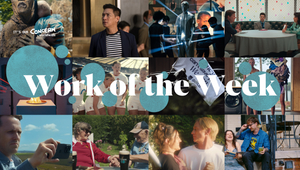
Can AI Actually Make Creative Work More Effective?

When it comes to generative AI (GAI), innovation and adoption curves are being written and rewritten almost every week. The large language models that help these systems work are gobbling up data as the tools that are built upon them expand their capabilities. Previous innovations in our industry, whether it’s blockchain enabled NFTs or ‘the metaverse’ lack two things that AI tools have in spades: a low barrier to entry and an ability to address very real pain points. This is probably why marketing and advertising have adopted generative AI faster, at 37%, than even technology companies (35%).
It should be noted that there are some very real and very worrying problems with generative AI as it stands. Biased data and models mean that the outcomes of image generators and text responses are less than efficient and there are also problems with IP as artists and creators sue https://www.techtarget.com/whatis/feature/AI-lawsuits-explained-Whos-getting-sued for the right to have their output removed from databases. That doesn’t mean we can’t all use generative AI programs, but it does mean that we need to act responsibly and use data that we can be assured is clear of copyright issues and bias.
GAI has the potential to create 97 million jobs by 2025, and could add as much as $4.4 trillion to the global economy. That impact is already being seen throughout agencies. Using large language models such as our own Omnicom tool ‘OMNI assist’, data can be queried at speed, meaning that account executives no longer have to spend weekends pulling together comparative reports. Furthermore, MidJourney prompts allow creatives to make decks that are sexier than ever before. Sadly though, If you’re not a prompt engineer then you are likely to be falling behind.
So with generative AI, efficiency gains are a given, AI is going to help us get to solutions faster. However, where I get really excited is the potential for GAI to transform our effectiveness, giving us access to scale and relevance like never before. Let’s look at that through the lens of three key parts of our business.
Data with soul
It feels strange to say that a machine with no grasp of emotion can help us get a more empathetic read on our data, but it’s true. In the past social listening was about as social as a sloth, and would often enthusiastically represent sarcasm as positive brand sentiment. Now, we can get access to signals that were previously buried deep in all manner of content and comments.
Giving each individual signal the love and attention it deserves can help to build an understanding of how our audiences really feel about their cats, chocolate bars and periods. AI isn’t able to write ads as creatively brilliant as that legendary Spotify campaign. But it can help us analyse data in a way that can give us the insight we need to write copy that is just as compelling.
Closing the gap between ideation and production
The bar for presenting creative work has been irreversibly raised by AI, and the effect it can have on visualisation of complex ideas or thoughts can’t be underestimated.
Our partners don’t have the benefit of spending weeks talking about a creative concept, so the ability to bring it to life through GAI, whether that’s visually in presentations or through quick VOs and storyboards is infinitely valuable. Even better, we now have the capability to actually make the impossible possible in production. At AlmapBBDO we were able to use AI to reunite one of the greatest Brazilian singers of all time, Elis Regina, with her daughter, a Brazilian singer with her own notoriety, for Volkswagen’s 70th anniversary. The result is beautifully emotional and nostalgic whilst being generated using AI. It delivered 50 million views and trended number one on X, Google and YouTube. An ad like this would have been previously impossible with traditional production techniques but with AI it could be visualised quickly and executed on a fraction of the budget.
Personalise like never before
If creative variations haven’t joined the list of buzzwords on creative briefs yet, then they will soon. Almost every ad server now uses AI to optimise on their platform. In theory that means providing a feedback loop that flags reasons for underperformance and pushes variations that are over-performing. As a result, this should mean that consumers are seeing the message that is likely to engage and resonate with them the best. We can increase this resonance by creating variations based on emotional insights for each audience category.
We can also use AI chatbots to provide support for our consumers. Sounds boring, but it really isn’t. We can train an AI with our brand tone and give it guardrails that make talking to it a funny, surprising and often genuinely useful experience. Data from our series of talking pets, made in partnership with Mars Petcare, one of our clients, suggests that offering support in this way makes consumers 250 times more likely to click through to purchase a product (vs an email benchmark).
It’s probably clear that I’m pretty excited about what AI can do for our industry. We are already seeing huge efficiency gains across the industry, but it’s what AI can do for the effectiveness of our advertising that really excites me. It can open our minds, provide texture, make the impossible possible and help us personalise with character. It’s going to be a fun year ahead.















